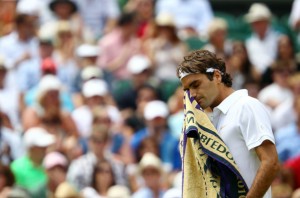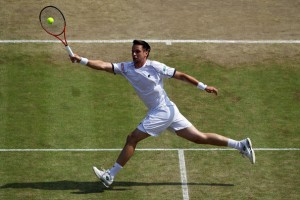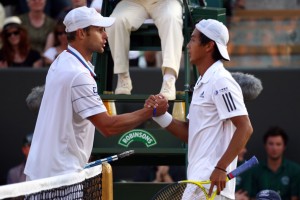Picking Up The Pieces After A Disappointing Wimbledon
Last time we looked at those who either met or exceeded their Wimbledon expectations. However, one player’s success at a major comes at another’s expense, and a surprise victory by one guy requires him to disrupt another’s plans. Here are some guys who left SW19 with regrets, and what we can expect from them on firmer footing.
Roger Federer: There certainly have been better times to be The Great Swiss. After a triumphant turn Down Under, Federer has not won a single tournament and has lost at the quarterfinal stage of the last two majors. That said, when one looks at each of the matches he’s lost this year —from Marcos Baghdatis in Indian Wells to Lleyton Hewitt in Halle—one sees that each match was competitive.
Even his four-set loss to Tomas Berdych at the All-England Club went four sets and Federer had break points as the Czech was trying to serve the match out. This indicates that a piece of the puzzle is missing, and if he finds it he’ll be back in the last weekend of majors.
I can’t tell you what that piece is, though; if Federer could tell us we probably wouldn’t be having to ask him about it.
The US Open is a month and a half away, and question is whether or not he can take the steps required to put himself back in contention there. His five straight titles from 2004-08 indicate that the surface suits his game just as well as grass and, as a bonus, suits Rafael Nadal’s game not so well.
However, it was at last year’s Open that the alarming trend of big guys with really big forehands who could simply hit through Federer’s more complete game began. Now a little more than a year removed from 30, the Swiss seems less able to counter their pace through defense, variety, and sheer wiliness.
He could hit the weight room, believing that greater strength would help him ward off the physical beating guys like Robin Soderling and Tomas Berdych inflict. He could also try updating his racket with more head space to improve his margin for error.
However, both of those steps require an adjustment that Federer probably won’t be interested in taking on with less than two months to go before the year’s last major, and a series of minor events to play between now and then.
One positive sign: A year and a half ago, with Nadal dominating the tour and questions about Federer’s ability to counter him circulating, the Swiss said that he had to work on his serve. A couple of months later, he was winning the Roland Garros final without being broken and then hitting 50 aces on the way to an epic Wimbledon triumph.
Federer has probably retreated after Wimbledon, looking to tweak some part of his game that has struggled as of late in time to reassert himself in New York. He’ll be 29 by then, so whether a technical fix is enough is the big question.
Robin Soderling: In many ways this was a successful Wimbledon for the Le Sod, who made American veteran Robbie Ginepri and up-and-coming Brazilian Thomaz Bellucci look well out of their weight classes in week one. Then he raced out to a 5-0 lead in the first set against Nadal and it looked like he was set to repeat the feat of Jim Courier in 1993: proving that on grass, the Big Forehand is the new first volley.
However, even in taking the first set of that match, Soderling ceded the momentum by allowing Nadal to grab back one break, and he facilitated that break by going for a reckless second serve ace down break point.
When Nadal is being outslugged he will, much like Andre Agassi used to, land little jabs that he can hopefully add to later. As the match progresses, and he starts forcing the big guy to run more, those little jabs add up and soon his opponent finds that he’s bruised all over.
Soderling did have a hurt foot, but the amount of running Nadal made him do probably had a lot to do with that.
Soderling’s lack of finesse and mobility don’t look good for his chances of winning a major one day. If he doesn’t learn to recognize a match’s critical points and play them accordingly, he has probably peaked. That realization is disappointing indeed.
Andy Roddick: To find a moment in the American’s career as low as this one, you have to go back pretty far. His early loss at Wimbledon 2008 was a setback, but he had recently missed several months due to a back injury.
His 2007 Wimbledon loss to Richard Gasquet had a remarkably similar score to his defeat this year against Yen-Hsun Lu, but that was against a young prodigy with vast quantities of untapped talent, not a 26-year-old journeyman whose heart and scrappiness masked a lack of offensive weapons.
Roddick’s preparation for this Wimbledon was not ideal, but we should explore his reasons for doing so. In 2008 he attempted to play a fuller season on the clay, which blunts his serve and requires more effort from him. What Roddick, then 25 (middle age for tennis pros) got for his troubles was the back injury that kept him out of Paris and sent him packing early in London.
Last year he tried playing a more abbreviated schedule on the dirt—just Madrid and Paris—and it paid off, as he achieved his best ever result at Roland Garros and missed out on the Wimbledon title by inches. He attempted to duplicate that this year, but his scheduled appearance at Madrid was derailed by illness, meaning he went into Paris with no preparation and London with an absence of momentum.
It’s unfortunate, because after his Miami win in the spring, momentum was something he had plenty of. Lacking much of a break in scheduling to tweak his game, Roddick arrives on North American hard courts cold. He’ll give it his all, like he always does, but it’s hard to see him matching his spring successes.
Larry Stefanki had better think fast, or get ready to send out résumés.



fpthhvxa